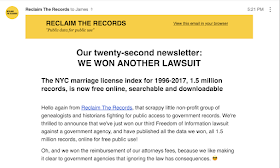We could go blithely along for years with our genealogical research and never be aware of the hazards that lurk just beneath our awareness. The main issues involve doing the math and checking the places where events were supposed to occur. As I examine existing pedigrees, I find the same hazards over and over again. The consequences of ignoring these hazards are the high probability that you have left your family line and are researching or working on the wrong, usually unrelated, people.
Here are some of the most common and most dangerous hazards.
Hazard #1
Failing to do the math.

This example of a flight of fancy is a good illustration of failing to do the math as well as several other hazards. This is a real entry in the
FamilySearch.org Family Tree. The Father in this example is 65 years old when the two children were supposed to be born. His wife, Alice, however, is only six years old when William and Ralph are born. The father could have had children but Alice is not the mother. Notice also that the grandparent William Malbon also had two children the same year.
If you think this is a ridiculous example, I suggest you start using your calculator to check the ages of those people you have in your own extended pedigree.
Hazard #2
Failing to check the places.
This is one of my most common themes in writing about genealogical research. This Malbon line is an excellent example of the kind of fuzzy thinking that ignores geography and history when doing genealogy. Here is an example
If you were to look at this part of a pedigree and didn't examine the locations listed, you might not catch the problem. Here are the people and their locations.
John Rogers b. 1612 in Breage, Cornwall, England and his son,
John Rogers b. 1636 in Trescowe, Cornwall, England and his daughter
Mary Rogers b. 1667 in England (no location listed) who marries
John Hovenden who was b. 1663 in Northiam, Sussex, England
Here's what that all looks like on a map.
The dates here are in the early 1600s. Absent an explanation about how this family in Cornwall had a daughter that married a man from Sussex, this is not at all defensible or likely.
Hazard #3
Choosing a similar name or whatever.
The short list above has a person named Mary Rogers who was listed like this:
She is supposed to have 6 sources which show that she was christened in Ticehurst, Sussex, England. However, her parents are shown as being from Cornwall. Actually, there are two sets of listed parents, one family is from Sussex. Which is correct? A quick check of the number of people named Mary Rogers in Sussex at that time shows the following from
Findmypast.com:
There are over 6,000 people shown in the records of Sussex County with the name of Mary Rogers. How many are there in Ticehurst? Only one.
She is not the Mary Rogers who was born in a family in Cornwall. Now, if you started to do the research on the Cornwall line, you would be off on an unrelated line.
There are a lot more hazards but these three cover the majority of the errors in many online family trees.







































